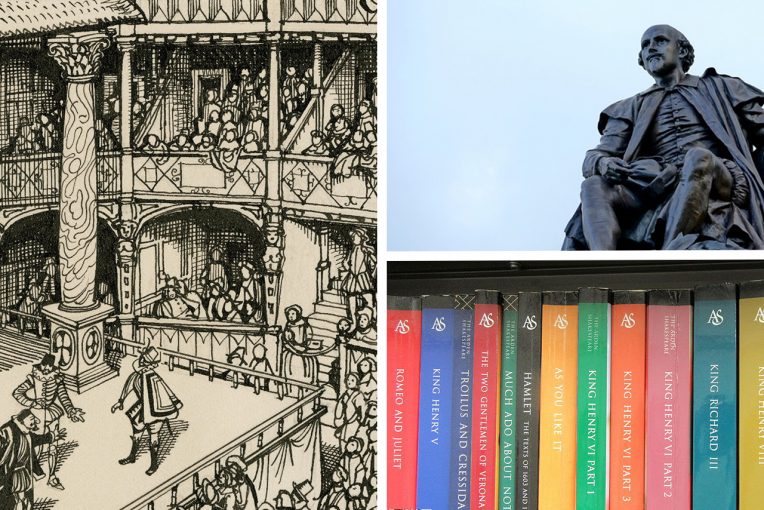“Double, double, toil and trouble; / Fire burn, and cauldron bubble.” These lines from Macbeth have become as famous as the three witches who chant them. But what is the context? In Act 4 Scene 1, the three witches are casting some kind of spell while dropping bizarre ingredients into a boiling cauldron. But they are not the only supernatural figures in the scene. Toward the end of their incantation, Hecate enters with three other witches, who do not have lines. They sing together until Macbeth interrupts them, demanding a follow-up to the prophecy he received earlier.
Hecate, the ancient goddess of the moon, magic, and witchcraft, appears in one other scene, but does not contribute anything meaningful to the plot of Macbeth. She does not interact with any of the characters besides the Weïrd Sisters, and only has a total of 39 lines in the play. She seems mainly to be there to make the witch scenes more spectacular, setting up the musical sequence to come. Some scholars believe that the scenes in which Hecate appears were added later for entertainment value, possibly penned by someone other than Shakespeare. In the 18th and 19th centuries, the witch scenes became quite elaborate, featuring a chorus of up to 60 singing witches in John Philip Kemble’s 1794 production, for example.

Modern adaptations of Macbeth usually reduce the witch scenes to focus on the main plot. As a result, Hecate is often cut. While this does not impact the story, it does have implications for the three witches. According to the First Folio version of the play, the Weïrd Sisters are but three members of a larger coven of witches with the goddess Hecate presiding over them. Indeed, Hecate announces herself to the witches as “the mistress of your charms, / The close contriver of all harms” (3.5.6-7). Conversely, the Weïrd Sisters themselves become powerful, omnipresent beings in the world of the play in Hecate’s absence. Some productions view them as the Three Fates in folklore—an interpretation that could be supported by the text, since the word weird is derived from wyrd, an Old English word meaning “fate.” If you only see three witches when you imagine the supernatural world of Macbeth, you may already be familiar with this modern trend of cutting Hecate.
ISF’s production, on the other hand, is keeping Hecate, although her scenes and lines have been mildly edited. Director Corey Allen has an interesting reason for this choice. He notes that Hecate’s name is invoked twice earlier in the play, both times by Macbeth as he describes the atmosphere of the night. Therefore, Hecate’s appearance is not just a random occurrence or a flimsy pretense for spectacle. Whether or not Shakespeare wrote the witch scenes, he was certainly thinking about the goddess’s presence in the dark and ominous world of this tragedy.
But who exactly is Hecate? In Greek mythology, Hecate is described as one of the Titans who sided with Zeus and was able to retain her powers. Shakespeare was probably drawing from the classical Greek and Roman tradition when invoking the goddess’s name—which he also does in several other plays, including Hamlet, King Lear, and A Midsummer Night’s Dream. But historically, Hecate was a broadly worshipped goddess who may have originated in other parts of the ancient Mediterranean world. In some later traditions, Hecate is conflated with Persephone, queen of the underworld, and thus becomes more closely associated with death, the night, and the moon (especially the dark side). From there on, Hecate would be seen as having control over ghosts and spirits. Her association with dark magic, drugs, and witches—which Macbeth draws on—likely solidified during the Hellenistic period.
Because of this long and complex history, Hecate is a difficult goddess to sum up. Aside from the associations mentioned above, she is also known as the triple-bodied goddess, often depicted as three female figures that overlap with one another or a single body with three faces. She was also seen as a protector of women and childbirth, which also reinforces her association with midwives (who were sometimes treated like witches). She was also regarded as a guardian of doors, portals, and crossroads, leading to some cultures erecting statues of Hecate in these spaces or leaving offerings to her there.
In that sense, Hecate is a liminal figure, a goddess who exists in the thresholds and in-between spaces of the world. It is significant that the Weïrd Sisters in Macbeth answer to this ancient goddess, rather than (as many people in Shakespeare’s time believed) the devil. Through Hecate’s presence in the play, the witches become manifestations of chaos and the unknowable—which is entirely different from being agents of evil. Hecate and the witches remind us that as much as we think that we know the world and are in control of our lives, there is always an “other side.” As Hecate says to the audience as much as the Weïrd Sisters who bow before her: “And you all know, security / Is mortals’ chiefest enemy” (3.5.32-33).


